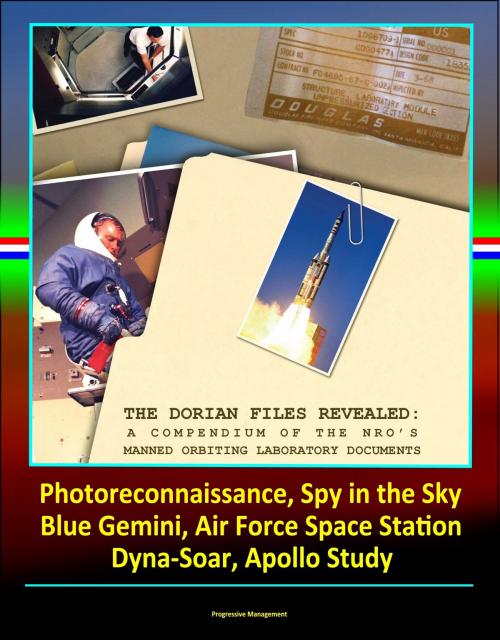The Dorian Files Revealed: A Compendium of the NRO's Manned Orbiting Laboratory (NRO) Documents, Photoreconnaissance, Spy in the Sky, Blue Gemini, Air Force Space Station, Dyna-Soar, Apollo Study
Nonfiction, Science & Nature, Technology, Aeronautics & Astronautics, History, Military, Aviation| Author: | Progressive Management | ISBN: | 9781310125126 |
| Publisher: | Progressive Management | Publication: | October 29, 2015 |
| Imprint: | Smashwords Edition | Language: | English |
| Author: | Progressive Management |
| ISBN: | 9781310125126 |
| Publisher: | Progressive Management |
| Publication: | October 29, 2015 |
| Imprint: | Smashwords Edition |
| Language: | English |
Professionally converted for accurate flowing-text e-book format reproduction, this newly released document from the National Reconnaissance Office (NRO) provides the first comprehensive, detailed history of the Manned Orbiting Laboratory (MOL) space program of the 1960s. It also includes Carl Berger's "A History of the Manned Orbiting Laboratory Program Office"
Contents: Chapter I: Early Space Station Planning * Chapter II: A National Space Station * Chapter III: DYNA-SOAR Killed, MOL Approved * Chapter IV: Planning the Manned Orbiting Laboratory December 1963-June 1964 * Chapter V: Evolution of the MOL Management Structure * Chapter VI: Results of the Pre-Phase I Investigation * Chapter VII: The Laboratory Vehicle Design Competition * Chapter VIII: The MOL Program Decision 25 August 1965 * Chapter IX: Organizing for Contract Definition * Chapter X: The Manned/Unmanned System Studies: 1965 - 1966 * Chapter XI: Budget, Developmental, and Schedule Problems: 1965-1966 * Chapter XII: Congress, MOL Security and the Range Controversy * Chapter XIII: Air Force / NASA Coordination * Chapter XIV: New Financial and Schedule Problems: 1967-1968 * Chapter 15: The Project Terminated * Chapter XVI: Post-Mortem
The Manned Orbiting Laboratory Program was publically disclosed from its early inception—first by the Air Force in 1963 and later by President Johnson in 1965 when the program was described as a means for advancing the military's use of space. Many elements of the program have been well known, including the identities of the men selected to serve as MOL crew members, the configuration of the launch vehicle used to place the MOL in orbit, and general details of some of the experiments that were planned for the vehicle. What has not been revealed, until now, is the extent to which the MOL was designed to serve as a platform for national reconnaissance collection.
The Manned Orbiting Laboratory, or MOL as it was known, promised to use space for the first time as a manned reconnaissance vantage point. If successful, the program could dramatically change the way the United States collected intelligence on its adversaries, including the nation's main foe, the Soviet Union. In order to gain both tactical and strategic intelligence on foes, nations have turned to the skies to gain a better vantage point for collecting intelligence. The United States developed in earnest active technical intelligence collection programs after World War II. The early efforts involved modification of military aircraft to fly near, and sometimes over, the denied areas of the Soviet Union and allied nations of the Soviets. The modified aircraft carried camera and signals collection equipment to capture activities in these closed areas. Unfortunately, US adversaries could down these aircraft, and did so on several occasions. Undeterred, the US developed aircraft specifically for airborne reconnaissance—first the U-2 and later the CIA's A-12 and the Air Force's variant, the SR-71. Both became obsolete for reconnaissance over the Soviet Union as Soviet air defenses improved as was manifested by the May 1960 downing of an U-2 over the Soviet Union, piloted by Francis Gary Powers.
Professionally converted for accurate flowing-text e-book format reproduction, this newly released document from the National Reconnaissance Office (NRO) provides the first comprehensive, detailed history of the Manned Orbiting Laboratory (MOL) space program of the 1960s. It also includes Carl Berger's "A History of the Manned Orbiting Laboratory Program Office"
Contents: Chapter I: Early Space Station Planning * Chapter II: A National Space Station * Chapter III: DYNA-SOAR Killed, MOL Approved * Chapter IV: Planning the Manned Orbiting Laboratory December 1963-June 1964 * Chapter V: Evolution of the MOL Management Structure * Chapter VI: Results of the Pre-Phase I Investigation * Chapter VII: The Laboratory Vehicle Design Competition * Chapter VIII: The MOL Program Decision 25 August 1965 * Chapter IX: Organizing for Contract Definition * Chapter X: The Manned/Unmanned System Studies: 1965 - 1966 * Chapter XI: Budget, Developmental, and Schedule Problems: 1965-1966 * Chapter XII: Congress, MOL Security and the Range Controversy * Chapter XIII: Air Force / NASA Coordination * Chapter XIV: New Financial and Schedule Problems: 1967-1968 * Chapter 15: The Project Terminated * Chapter XVI: Post-Mortem
The Manned Orbiting Laboratory Program was publically disclosed from its early inception—first by the Air Force in 1963 and later by President Johnson in 1965 when the program was described as a means for advancing the military's use of space. Many elements of the program have been well known, including the identities of the men selected to serve as MOL crew members, the configuration of the launch vehicle used to place the MOL in orbit, and general details of some of the experiments that were planned for the vehicle. What has not been revealed, until now, is the extent to which the MOL was designed to serve as a platform for national reconnaissance collection.
The Manned Orbiting Laboratory, or MOL as it was known, promised to use space for the first time as a manned reconnaissance vantage point. If successful, the program could dramatically change the way the United States collected intelligence on its adversaries, including the nation's main foe, the Soviet Union. In order to gain both tactical and strategic intelligence on foes, nations have turned to the skies to gain a better vantage point for collecting intelligence. The United States developed in earnest active technical intelligence collection programs after World War II. The early efforts involved modification of military aircraft to fly near, and sometimes over, the denied areas of the Soviet Union and allied nations of the Soviets. The modified aircraft carried camera and signals collection equipment to capture activities in these closed areas. Unfortunately, US adversaries could down these aircraft, and did so on several occasions. Undeterred, the US developed aircraft specifically for airborne reconnaissance—first the U-2 and later the CIA's A-12 and the Air Force's variant, the SR-71. Both became obsolete for reconnaissance over the Soviet Union as Soviet air defenses improved as was manifested by the May 1960 downing of an U-2 over the Soviet Union, piloted by Francis Gary Powers.















